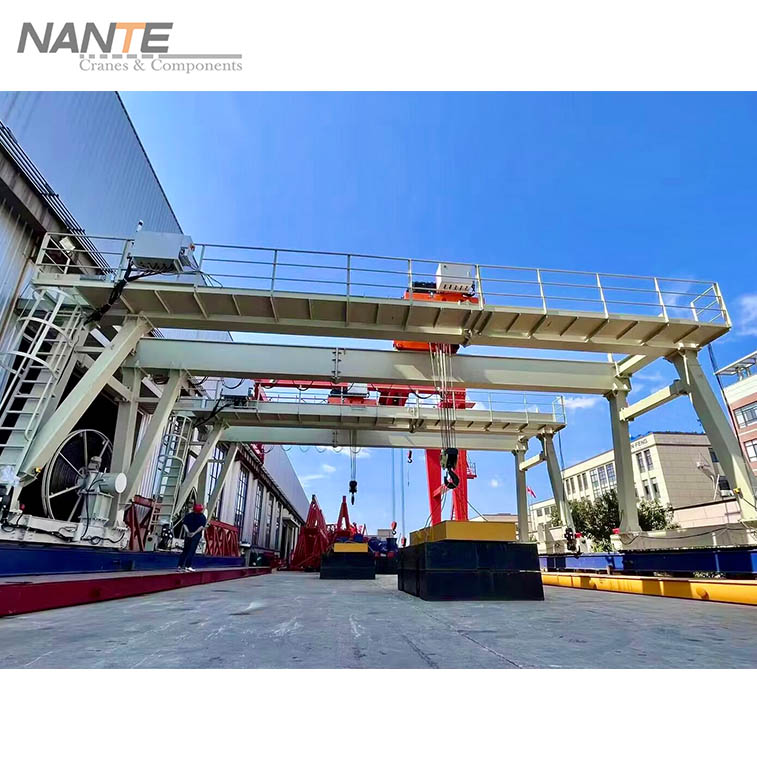The Ultimate Guide to Mastering Gantry Crane Operation Training
Date: 2024-05-02 Share:
Understanding Gantry Crane Basics
Gantry cranes are an essential part of many industrial operations, providing a versatile and efficient means of lifting and moving heavy loads. The crane machine itself consists of a bridge supported by two or more legs that run on wheels or along a track. This design allows the crane to move horizontally along the gantry structure, providing flexibility in positioning and transporting materials within a facility.
In various industries, gantry cranes play a crucial role in streamlining production processes. They are commonly used in manufacturing facilities, warehouses, construction sites, and shipyards for tasks such as loading and unloading cargo, assembling heavy equipment, and transporting materials across large areas. The adaptability of gantry cranes makes them indispensable for handling diverse loads with precision and efficiency.
Proper training to use gantry cranes is paramount to ensuring operational safety and efficiency. Safety protocols must be ingrained in every operator’s routine to prevent accidents and protect personnel from potential hazards. Additionally, comprehensive training enhances operational efficiency by equipping operators with the skills to handle complex tasks effectively while minimizing downtime due to errors or accidents.
Key Components of Gantry Crane Training

Gantry crane training encompasses a range of essential components that equip operators with the knowledge and skills required to operate these powerful machines safely and efficiently.
Classroom and Online Training Modules
Comprehensive gantry crane training often begins with a combination of classroom and online modules. These modules cover crucial aspects such as crane mechanics and operational safety protocols. Understanding the gantry crane mechanics is fundamental to operating the equipment effectively. It involves learning about the different types of gantry cranes, their structural components, and how they function to lift and transport heavy loads within industrial settings.
Operational safety protocols are equally vital in gantry crane training. They encompass guidelines for safe operation, hazard identification, emergency procedures, and compliance with industry standards such as OSHA and ASME B30.2. As emphasized by Crane Expert Witness, “A crane expert witness is an individual with specialized knowledge and experience in crane operations, safety standards, regulations, and industry best practices.”
Incorporating both classroom-based learning and online resources allows trainees to grasp theoretical concepts while also having the flexibility to engage with interactive e-learning materials at their own pace.
Hands-On Training: Getting to Know Your Crane Machine
Hands-on training is a critical component of gantry crane operation training. Practical exercises involving gantry cranes provide trainees with invaluable experience in maneuvering loads, positioning the crane accurately, and understanding the nuances of load dynamics. This hands-on experience allows operators to develop a deep understanding of how to operate the equipment safely while maximizing efficiency.
Supervised operation during training sessions ensures that individuals receive real-time feedback from experienced instructors. This feedback helps in refining operational techniques, enhancing situational awareness, and fostering a culture of continuous improvement in gantry crane operation.
By combining theoretical knowledge with practical application, trainees can gain a comprehensive understanding of gantry crane operations while honing their skills under expert supervision.
The Path to Gantry Crane Operation Certification
Meeting the Requirements: Training to Use Gantry Cranes
When it comes to operating gantry cranes, meeting the necessary training requirements is essential for ensuring safety and compliance with industry standards. Both OSHA and ASME B30.2 have established specific regulations and standards that govern the construction, installation, operation, inspection, and maintenance of overhead and gantry cranes.
OSHA 1910.179, titled “Overhead and Gantry Cranes,” outlines the detailed regulations for these types of cranes. It specifies the requirements for their construction, installation, operation, inspection, and maintenance. This comprehensive document serves as a crucial guide for crane operators and training programs to ensure adherence to safety protocols and operational best practices.
Similarly, ASME B30.2 provides specific standards for overhead and gantry cranes. These standards cover various aspects such as construction, installation, operation, inspection, and maintenance of these types of cranes. Adhering to these standards is vital in ensuring the safe and efficient use of gantry cranes within industrial settings.
The certification process for gantry crane operation involves rigorous training that aligns with these regulatory requirements. It encompasses theoretical knowledge about crane mechanics, operational safety protocols, hazard identification procedures, emergency response guidelines, compliance with OSHA/ASME standards, and practical hands-on experience in operating gantry cranes.
Beyond Certification: Continuous Learning and Skill Enhancement
Gantry crane operators should view certification as a stepping stone towards continuous learning and skill enhancement. Advanced training opportunities are available to further refine operational techniques and expand knowledge in specialized areas related to gantry crane operations.
These advanced training programs cover a wide range of topics such as load dynamics analysis, advanced rigging techniques, specialized lifting operations (e.g., container handling), preventive maintenance procedures for gantry cranes, and emergency response simulations. By participating in these programs, operators can deepen their expertise while staying updated on industry best practices.
Keeping up with Industry Standards and Innovations
Staying abreast of industry standards and innovations is crucial for gantry crane operators seeking continuous professional development. As technology evolves in the realm of material handling equipment like gantry cranes, it’s essential for operators to stay informed about new advancements that could enhance operational efficiency or introduce improved safety features.
Professional networks provide valuable platforms for sharing insights on industry trends, technological advancements in crane design or automation systems integration into crane operations. Joining these networks allows operators to engage in discussions about best practices while gaining exposure to cutting-edge innovations in gantry crane technology.
Maintaining Proficiency and Safety in Gantry Crane Operation

As technology and industry standards evolve, the proficiency and safety of gantry crane operation rely on continuous learning and skill enhancement. This section delves into the significance of regular refresher courses and best practices for safe gantry crane operation.
The Role of Regular Refresher Courses
Why Continuous Training is Essential
Continuous training is essential for gantry crane operators to stay updated with the latest safety protocols, operational techniques, and industry innovations. A new crane safety study analyzed 249 industrial overhead crane incidents, revealing insights into crane safety. This study demonstrated the effectiveness of continuous training programs in maintaining safety by highlighting the importance of ongoing education in preventing accidents and promoting a culture of vigilance among operators.
Regular refresher courses provide opportunities for operators to review and reinforce their knowledge, address any gaps in understanding, and stay informed about any regulatory updates or technological advancements. By engaging in continuous training, operators can enhance their expertise, refine their skills, and adapt to changes within the dynamic industrial landscape.
Updating Skills and Knowledge
Updating skills and knowledge through regular refresher courses ensures that operators remain proficient in gantry crane operations. These courses cover a range of topics such as advanced rigging techniques, emergency response simulations, and preventive maintenance procedures. By participating in these courses, operators can deepen their understanding of gantry cranes while honing their skills to handle complex tasks effectively.
Continuous training also fosters a mindset of continuous improvement among operators. It encourages them to seek out new information, refine their operational techniques, and stay abreast of best practices within the industry. This proactive approach not only enhances operational efficiency but also contributes to a safer working environment for all personnel involved in gantry crane operations.
Best Practices for Safe Gantry Crane Operation
Daily Checklists and Routine Inspections
Implementing daily checklists and routine inspections is crucial for ensuring safe gantry crane operations. Operators should conduct comprehensive pre-operational checks to verify that all components are functioning properly before commencing any lifting activities. These checks encompass examining structural integrity, verifying control mechanisms, inspecting wire ropes or chains for signs of wear or damage, and ensuring that all safety devices are operational.
Routine inspections further contribute to maintaining proficiency and safety in gantry crane operation by identifying potential issues early on. By adhering to a structured inspection regimen, operators can detect any anomalies or malfunctions promptly, allowing for timely corrective actions to be taken before they escalate into more significant problems.
Creating a Culture of Safety
Creating a culture of safety is paramount in promoting best practices for gantry crane operation. Operators should prioritize open communication regarding safety concerns or observations related to equipment performance. Encouraging reporting on near-misses or potential hazards fosters an environment where proactive measures can be implemented to mitigate risks effectively.
Additionally, establishing clear protocols for emergency response scenarios ensures that all personnel are well-prepared to handle unexpected situations during gantry crane operations. By integrating safety awareness into daily routines and emphasizing collective responsibility for maintaining a safe working environment, organizations can cultivate a culture where safety is ingrained as an integral part of every operation.
Nante Crane
Nante Crane is a leading crane and crane components designer and manufacturer based in China. With a strong focus on research and development, the company is dedicated to advancing lifting and material handling technologies. By adopting innovative ideas and designs, Nante Crane consistently delivers high-quality lifting equipment and components to its customers.
Nante Crane offers a wide range of products, including industrial cranes, offshore cranes, launching cranes, electric hoists, crane travel units, and mobile power supply systems. These products are known for their reliable and excellent performance. Nante Crane has achieved significant breakthroughs in core technology and has the capability to manufacture core components used in various industries such as advanced manufacturing, logistics, paper making, mining and energy, automobiles and ships, metal processing, and aerospace.
Continuously innovating and upgrading its technologies, products, solutions, and services, Nante Crane keeps pace with the demands of the new era of industrial manufacturing 4.0 and safety upgrades. The company aims to be powered by people and driven by technological innovation, constantly creating value for its customers and contributing to the development of the material handling industry.
Final Thoughts on Mastering Gantry Crane Operation Training
The Journey to Becoming a Proficient Gantry Crane Operator
Becoming a proficient gantry crane operator is a journey that requires unwavering commitment to learning and safety. It involves more than just acquiring technical skills; it entails a deep understanding of operational protocols, safety standards, and the ability to adapt to dynamic industrial environments.
Commitment to Learning and Safety
A key aspect of the journey to proficiency in gantry crane operation is the commitment to ongoing learning and skill enhancement. Operators must prioritize continuous training, staying updated with industry best practices, and refining their operational techniques through advanced training opportunities. This commitment not only fosters personal growth but also contributes to creating a safer working environment for all personnel involved in gantry crane operations.
The Importance of Hands-On Experience
Hands-on experience plays an indispensable role in mastering gantry crane operation. It provides operators with practical insights into load dynamics, equipment maneuverability, and real-time decision-making in various operational scenarios. Through hands-on experience, operators develop the confidence and expertise required to handle complex tasks effectively while prioritizing safety at every step.
Resources for Further Learning
Where to Find Advanced Training
For those seeking advanced training in gantry crane operation, there are reputable institutions and organizations that offer specialized courses tailored to enhance operational proficiency. These programs delve into advanced rigging techniques, specialized lifting operations, preventive maintenance procedures, and emergency response simulations. By enrolling in these courses, operators can expand their knowledge base while honing their skills under expert guidance.
Joining Professional Networks and Communities
Professional networks and communities provide valuable platforms for operators to engage with industry experts, share insights on best practices, and stay informed about technological advancements in crane design and safety protocols. Engaging in these networks fosters a culture of knowledge exchange while offering opportunities for continuous professional development within the realm of gantry crane operations.
 English
English






